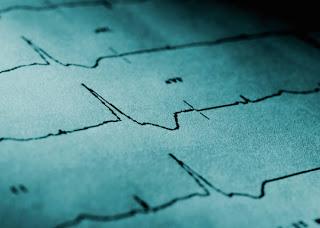
Congenital long QT syndrome (LQTS) is an inherited condition that affects heart muscle cells and predisposes individuals to potentially fatal ventricular arrhythmias. This condition manifests (usually) with a prolonged time interval between the Q and T waves of the EKG and the occurence of either syncope (blacking out due to an arrhythmia) or sudden cardiac death (SCD) that is usually triggered by emotional stress or exercise.
Genetics
Much progress has been made with our understanding of the genetics of LQTS. At least 13 different, but related, responsible genetic defects have been identified. They all affect ion channels in the cell membranes of heart muscle cells and affect the way that electrical impulses travel through the heart. The 3 most common genetic types are LQT1 (accounting for 40-55% of patients), LQT2 (30-45%), and LQT3 (5-10%). Because these genetic defects affect the ion channels, LQTS is sometimes called a "channelopathy."
The prevalence is usually said to be approximately 1 per 2000 individuals.
The triggers for lethal and non-lethal cardiac events are different for the genetic subtypes. For carriers of LQT1, the most common trigger is exercise. For carriers of LQT2, exercise is an very uncommon trigger; emotion may be a trigger, but most events occur during sleep or rest without arousal. For carriers of LQT3, few events are triggered by exercise or emotion.
Diagnosis
Most patients come to attention because of a known family history or because of an episode of cardiac syncope or SCD with successful resuscitation.
Most, but not all affected individuals will have prolongation of the QT interval on the EKG. Even without genetic testing, the diagnosis is usually established using a set of diagnostic criteria organized into 3 sections that produce a "Priori-Schwartz score":
EKG findings
QTc >= 480 msec [3 points]
QTc 460-479 msec [2 points]
QTc 450-459 msec, for men [1 point]
QTc 4th minute of recovery from exercise stress test >=480 msec [1 point]
Torsades-de-Pointes [2 points]
T-wave alternans [1 point]
Notched T wave in 3 leads [1 point]
Low heart rate for age [0.5 point]
Clinical history
Syncope [2 points]
With stress [1 point]
Without stress [1 point]
Congenital deafness [0.5 points]
Family history
Family members with definite LQTS1 [1 point]
Unexplained sudden cardiac death younger than age 30 in family member [0.5 point]
A score of 3.5 points indicates a high probability of LQTS. Some authorities recommend genetic screening for individuals with scores of greater than 3.0 points.
Treatment
Left untreated, symptomatic patients with LQTS have a mortality rate of ~20% in the first year.
Medical therapy includes beta-blockers (eg, propranolol, nadolol). The effectiveness of these medications may depend upon the genetic subtype, but further investigation is ongoing.
One potential surgical option is left cardiac sympathetic denervation (LCSD), a procedure where the ordinarily stimulatory sympathetic nerves are disrupted. This operation can be performed either in an "open" approach or by a thoracoscopic approach. In either case, the first several thoracic ganglia (nerves) are removed. Studies have shown this technique to be effective, particularly among patients with cardiac events despite beta-blocker usage and among patients with problems of various sorts with an implantable cardioverter-defibrillator (ICD).
The ICD is the remaining treatment option. A device is implanted that includes a computer, battery, and leads that are attached to the heart. In the event of a potentially fatal arrhythmia, the device provides a shock to terminate the arrhythmia and restore the normal heart rhythm.
Athletes and LQTS
Consensus guidelines for athletes with LQTS are provided in the Proceedings of the 36th Bethesda Conference. These guidelines recognize that there is not sufficient information (yet) to stratify the risk of SCD for the various genetic subtypes, so a single set of recommendations was offered:
1. Activity should be restricted to low-intensity sports (eg, billiards, golf, curling, riflery) for athletes with LQTS who have had cardiac arrest or an episode of syncope.
2. Asymptomatic athletes with prolongation of the QT interval on the EKG should be restricted to low-intensity sports.
3. Asymptomatic athletes, who are known gene carriers, may participate fully in their sports.
4. Athletes with an ICD should participate only in low-intensity sports and should avoid all situations where bodily injury might occur.
Related Posts
1. Index to all of the posts at AthletesHeart
